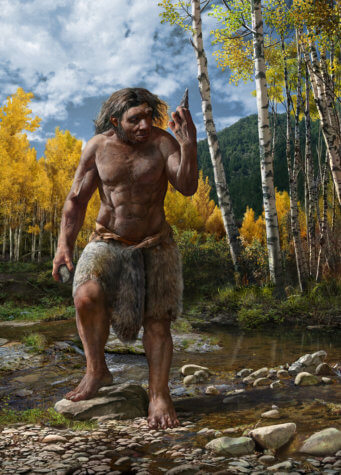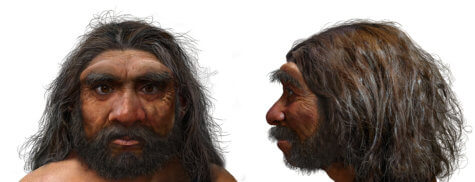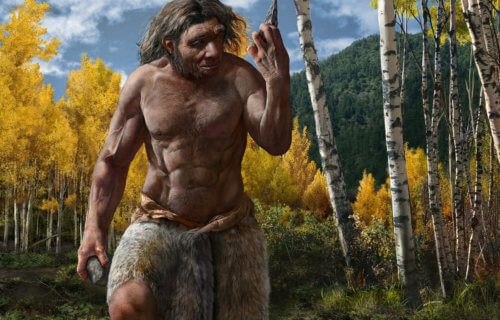SHIJIAZHUANG, China — “Dragon man,” who scientists say lived 146,000 years ago and is modern mankind’s closest relative, has had its remains positively identified in China. Their research reveals the hairy giant, standing taller than a modern human, is our “long lost sibling” and is closer to us than Neanderthals.
Study authors believe he had big square eyes, a thick brow, massive mouth, and huge teeth with an enormous skull. Moreover, their skull was large enough to hold a brain the same size as ours. Researchers dug up these fossils in Harbin City, Heilongjiang, China. They appear to belong to a male who was about 50 years-old when he died.
Named Homo longi, or Dragon man, researchers say he lived in the forest 146,000 years ago. The mysterious individual was stocky like a Neanderthal, but was lighter skinned than other early humans. This early human may have belonged to a small community that roamed a wooded floodplain.

“Like Homo sapiens, they hunted mammals and birds, and gathered fruits and vegetables, and perhaps even caught fish,” says co-author Professor Xijun Ni of the Chinese Academy of Sciences in a media release.
“It is probably safe to say the height of this individual was higher than the average of modern humans.”
Mankind’s story is getting more complex
Mankind’s story has grown increasingly complex in recent years and Dragon Man is the latest character to enter the mix.
“The Harbin fossil is one of the most complete human cranial fossils in the world,” adds lead author Prof. Qiang Ji, a paleontology at Hebei GEO University. “This fossil preserved many morphological details that are critical for understanding the evolution of the Homo genus and the origin of Homo sapiens.”
The almost perfectly preserved relic is housed in the university’s Geoscience Museum. Researchers unearthed it from the bottom of the Songhua River in 1933 and it’s the largest human skull ever discovered. Now, nearly nine decades than later, scientists can confirm it represents a new species.
Hominins, or early humans, began migrating out of Africa some two million years ago. Recent discoveries show China was teeming with different types of humans between 900,000 and 125,000 years ago. As the early adventurers made their way into foreign lands and climates, they diversified into an array of populations.
Neanderthal forerunners spread through Europe and the Middle East. Other hominins headed for south east Asia. They gave rise to the short-statured Homo floresiensis, nicknamed The Hobbit, in present day Indonesia and the stone tool users of the Philippines. Dragon man, described in three studies in The Innovation, replaces Neanderthals as our nearest ancestor. He has the potential to “reshape our understanding of human evolution,” according to the international team.
“While it shows typical archaic human features, the Harbin cranium presents a mosaic combination of primitive and derived characters setting itself apart from all the other previously-named Homo species,” Prof. Ji explains.
Is Dragon man the missing piece in human evolution?

Study authors think Dragon Man was likely very tall and muscular. Given where the skull was found, they also believe he was well adapted for harsh environments. This would enable this species to disperse throughout Asia.
The team dated the fossilized skull using complicated geochemical techniques. These placed it in the Middle Pleistocene, a dynamic era of human species migration. It is possible Dragon Man and Homo sapiens encountered each other on the way and may have even mated.
“We see multiple evolutionary lineages of Homo species and populations co-existing in Asia, Africa, and Europe during that time,” says co-author Professor Chris Stringer of London’s Natural History Museum. “So, if Homo sapiens indeed got to East Asia that early, they could have a chance to interact with H. longi, and since we don’t know when the Harbin group disappeared, there could have been later encounters as well.”
“We can guess from the massive cranium this individual was large and probably heavily built,” he adds in a statement to SWNS. “Without a skeleton, we cannot estimate the height. From the winter temperatures in Harbin today it looks like they were coping with even harsher cold than the Neanderthals. This probably required adaptations both cultural – such as clothing, shelters and fire – and physical like a wide body shape and subcutaneous fat.”
Prof. Stringer believes Dragon Man is a “remarkable new piece in the jigsaw of human evolution.”
“The cranium is almost intact, with the main loss being all of its teeth apart from one huge second molar – and it is massive in size.”
Did Dragon man interact with modern humans too?
Looking further back in time confirmed he is more closely related to modern humans than Neanderthals.
“It is widely believed the Neanderthal belongs to an extinct lineage that is the closest relative of our own species,” Prof. Ni tells SWNS. “However, our discovery suggests that the new lineage we identified that includes Homo longi is the actual sister group of H. sapiens.”

The reconstruction of the human tree of life also shows the common ancestor we share with Neanderthals is even older.
“The divergence time between H. sapiens and the Neanderthals may be even deeper in evolutionary history than generally believed, over one million years,” Prof. Ni continues.
If true, humans diverged from Neanderthals roughly 400,000 years earlier than scientists had thought. The skull could rewrite human evolution. Analysis of the life of Dragon Man suggest they were strong and robust. Their interactions with Homo sapiens may have shaped our history in turn.
“Altogether, the Harbin cranium provides more evidence for us to understand Homo diversity and evolutionary relationships among these diverse Homo species and populations,” Prof Ni concludes. “We found our long-lost sister lineage.”
SWNS writer Mark Waghorn contributed to this report.
